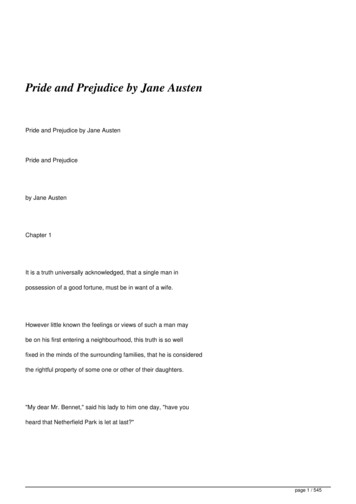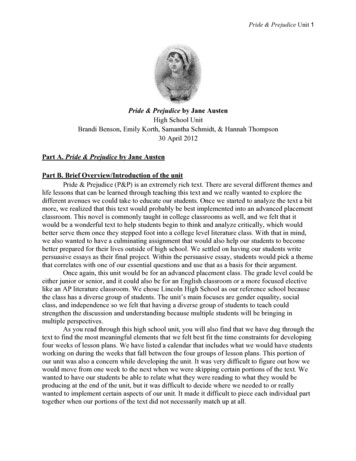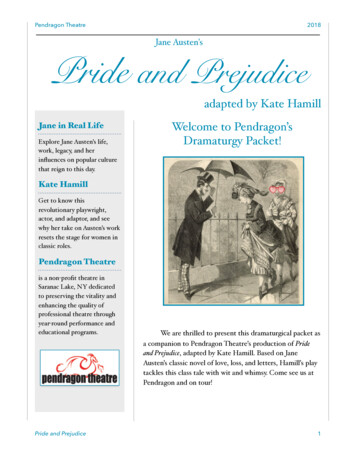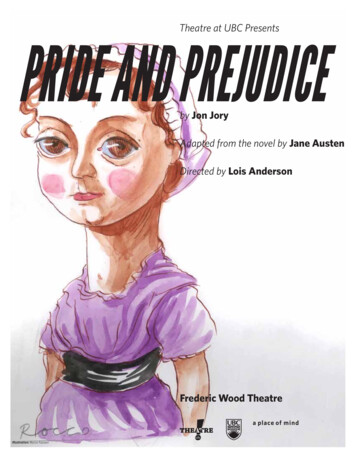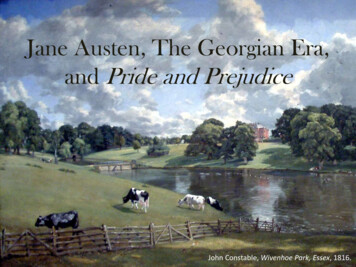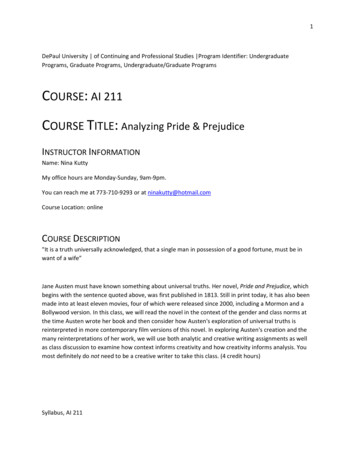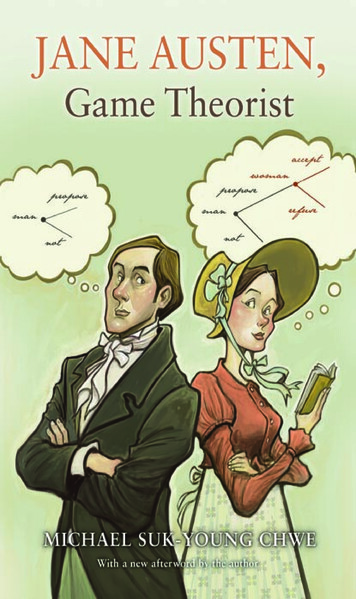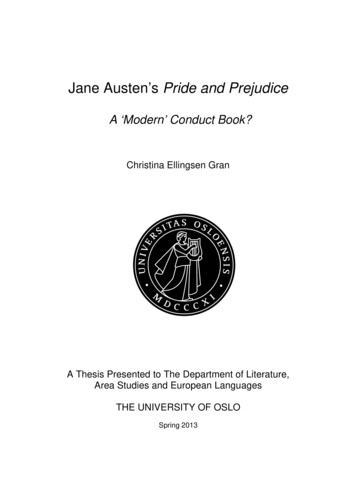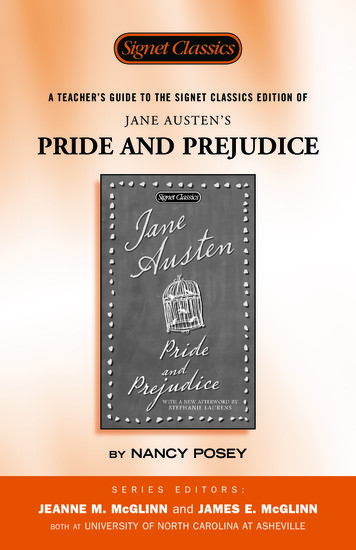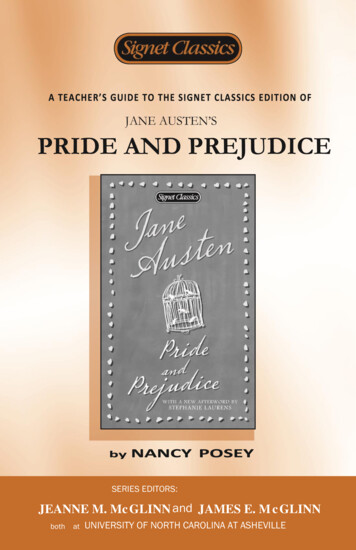
Transcription
JANE AUSTEN’SPRIDE AND PREJUDICESERIES EDITORS:JEANNE M. Mc GLINN and JAMES E. M c GLINNbothatUNIVERSITY OF NORTH CAROLINA AT ASHEVILLE
2A Teacher’s Guide to the Signet Classics Edition of Jane Austen’s Pride and PrejudiceTABLE OF CONTENTSINTRODUCTION . 3LIST OF CHARACTERS . 4SYNOPSIS OF THE NOVEL . 5PRE-READING ACTIVITIES . 8I. BUILDING BACKGROUND KNOWLEDGE . 8II. GENRE STUDY . 15III. INITIAL EXPLORATION OF THEMES . 16DURING READING ACTIVITIES . 19I. NOTING INITIAL REACTIONS . 19II. READER RESPONSE . 21III. FOCUSING ON THE LITERARY ELEMENTS . 22IV. DISCUSSION QUESTIONS . 27V. VOCABULARY DEVELOPMENT . 31AFTER READING ACTIVITIES . 33I. ANALYSIS OF INITIAL REACTIONS . 33II. DEEPENING UNDERSTANDING . 34III. INDIVIDUAL AND GROUP PROJECTS . 35MORE RESOURCES FOR TEACHERS . 44ABOUT THE AUTHOR OF THIS GUIDE . 45ABOUT THE EDITORS OF THIS GUIDE . 45FREE TEACHER’S GUIDES . 46Copyright 2009 by Penguin Group (USA)Get free e-books and video tutorials at www.passuneb.com
A Teacher’s Guide to the Signet Classics Edition of Jane Austen’s Pride and Prejudice3For additional teacher’s manuals, catalogs, or descriptive brochures, please emailacademic@penguin.com or write to:PENGUIN GROUP (USA) INC.In Canada, write to:Academic Marketing DepartmentPENGUIN BOOKS CANADA LTD.375 Hudson StreetAcademic SalesNew York, NY 10014-3657 90 Eglinton Ave. East, Ste. 700http://www.penguin.com/academic Toronto, OntarioCanada M4P 2Y3Printed in the United States of AmericaINTRODUCTIONFor a young woman living a presumably insular life in Regency England, JaneAusten produced an impressive body of works that has continued to grow inpopularity. She was born in 1775 in Hampshire, England to a parson’s family,and she left home only for five years to attend boarding school and foroccasional visits to siblings. Surrounded by books all of her life, she found aneager audience for her writing among her close-knit family. Although shenever married and had only one serious romance, her novels of courtship andmarriage have remained favorites.Austen completed the first draft of Pride and Prejudice, which she titled FirstImpressions, in 1797, but it was not published until after she had rewritten itnearly sixteen years later. Of her six complete novels, Pride and Prejudice seemsto have been her favorite. In a letter to her sister Cassandra she referred to thebook as her “darling child” and called her protagonist Elizabeth Bennet “asdelightful a character as ever appeared in print.”Jane Austen’s work seems little touched by political events in her world or bymajor literary trends of her day. She focuses instead on themes of social class,middle class manners, gender issues, courtship and marriage, all of whichcome together in Pride and Prejudice. Perhaps it is these timeless themes thatdraw readers back again and again to this novel.This guide aims to assist teachers in planning to teach the novel in ways thatwill make it accessible to the range of readers in contemporary classrooms. Tothis end there are suggestions for preparing students to read the novel withGet free e-books and video tutorials at www.passuneb.com
4A Teacher’s Guide to the Signet Classics Edition of Jane Austen’s Pride and Prejudicesensitivity to Austen’s setting and themes. During-reading activities areincluded that will facilitate students’ reading the novel actively withcomprehension. The post-reading activities are aimed at encouraging adeeper exploration of the content of the novel and making connections withother literary works. The variety of activities presented here can be usedselectively by teachers in addressing their goals for teaching the novel andresponding to the needs of their students.LIST OF CHARACTERSTHE BENNET FAMILY AND FRIENDSElizabeth Bennet—protagonist, the second of five daughters; pragmatic andindependent; her father’s favoriteMiss Jane Bennet—Elizabeth’s older sister; wants to see the best in everyone;Mary Bennett—the plain, bookish middle sisterMiss Catherine (Kitty) Bennett—easily led and shallow fourth daughterLydia Bennet—the youngest sister, flirty and undisciplinedMr. Bennet—their father, cynical and permissiveMrs. Bennet—their mother, whose main goal is to find husbands for herdaughtersCharlotte Lucas—Elizabeth’s best friendSir William and Mrs. Lucas—The Bennets’ neighborsMr. Collins—the Bennet girls’ overbearing cousin, a priggish clergyman whostands to inherit Longbourn, the Bennets’ entailed estateThe Gardiners—Mrs. Bennet’s brother and sister-in-law who live in LondonGeorge Wickham—an attractive militia officer stationed near the BennetsTHE BINGLEY FAMILY AND FRIENDSGet free e-books and video tutorials at www.passuneb.com
A Teacher’s Guide to the Signet Classics Edition of Jane Austen’s Pride and Prejudice5Mr. Charles Bingley—unmarried, wealthy young man who has leased nearbyNetherfieldMiss Caroline Bingley—Mr. Bingley’s sisterMrs. Hurst—Bingley’s married sisterMr. Hurst—Bingley’s brother-in-lawMr. Fitzwilliam Darcy—Bingley’s prideful, wealthy friendMiss Darcy—Darcy’s sisterCol. Fitzwilliam—a relation of Darcy whose status as second son leaves himwith little wealthLady Catherine de Bourgh—a condescending wealthy snob; patron of Collins;aunt of DarcySYNOPSIS OF THE NOVELVOLUME ICHAPTER 1-6 MEETING THE BENNETS AND THEIR NEIGHBORSThe narrator introduces the Bennet family and Mrs. Bennet’s interest in theirnew neighbor, Mr. Bingley, “a single man of large fortune,” who has just rentedNetherfield Park. After several dinners and visits, it is obvious that Bingley isattentive to Jane. However, his friend Darcy snubs the group, particularlyElizabeth, and is judged critically by the locals. The two men are contrasted—their personalities as well as their circumstances—as are Jane and Elizabethand their judgments. Visiting their neighbors the Lucas’s, Mrs. Bennet and thegirls have a chance to discuss Bingley and Darcy at length. Jane withholds herfeelings, while Charlotte Lucas has a more pragmatic view of marriage. Readerslearn that Darcy has taken an interest, against his will, in Elizabeth.Get free e-books and video tutorials at www.passuneb.com
6A Teacher’s Guide to the Signet Classics Edition of Jane Austen’s Pride and PrejudiceCHAPTER 7-12 VISIT TO NETHERFIELDJane is invited to Netherfield by Bingley’s sisters, and, caught in the rain on herway, comes down with a bad cold. Elizabeth goes to check on her and is invitedto stay as well. She is able to observe the others’ true colors without Jane’spresence. Mrs. Bennet and Lydia come to Netherfield to check on Jane, andElizabeth is caught between embarrassment for her mother and family loyalty.Elizabeth and Darcy engage in a battle of wits. When Jane’s health improves,the girls return home.CHAPTER 13-22 MR. COLLINS VISITS LONGBOURNMr. Bennet receives a letter from Mr. Collins, the male heir in line to inherit thefamily’s entailed estate (since there are no sons). He proves to be a silly man,easily impressed by wealth and status. During his visit, the group encountersWickham, a member of the militia stationed at Meryton for the winter. It isclear that he and Darcy are not on friendly terms.All the neighborhood eagerly anticipates a ball at Netherfield, hosted byBingley. Elizabeth is dismayed by Collins’ interest in her, Wickham’s absence,and the behavior of her family. She and Darcy dance and verbally spar. Thenext day, Collins proposes marriage to Elizabeth and is surprised by her refusal.Mrs. Bennet presses for the match, though her husband does not. Spurned byElizabeth, Collins instead proposes to Charlotte Lucas, who accepts but not outof love. Jane learns that the Netherfield party has returned to London with noplans to return. Bingley’s departure and the prospect of Charlotte as mistressof Longbourn displease Mrs. Bennet.VOLUME IICHAPTER 1-3 CHANGING IMPRESSIONSA letter from Miss Bingley to Jane, which suggests that Charles Bingley iscourting Miss Darcy, ends her hopes that he will return. Meanwhile Collinsmakes preparations for his marriage, and the Gardiners, Mrs. Bennet’s brotherand his wife, invite Jane for a visit to London. She accepts with some hopeGet free e-books and video tutorials at www.passuneb.com
A Teacher’s Guide to the Signet Classics Edition of Jane Austen’s Pride and Prejudice7perhaps of seeing Bingley. Jane’s letters to Elizabeth indicate she now seesMiss Bingley for what she is. Elizabeth is no longer involved with Wickham.CHAPTER 4-14 ELIZABETH AND THE GARDINERS VISIT THE COLLINSElizabeth visits her aunt and uncle, traveling with them to visit Charlotte andMr. Collins at their home in Hansford. They find Collins little changed, butCharlotte quite content. They are invited to Rosings, where they get a clearview of the imperial Lady Catherine and her mousy daughter. During their stay,Darcy arrives with his cousin Col. Fitzwilliam. Elizabeth and Darcy continue theirverbal jousting.Elizabeth encounters Darcy often—at Rosings and on her walks. She learnsfrom Fitzwilliams Darcy’s role in separating Bingley and Jane. Darcy catchesElizabeth off guard with his proposal of marriage, an offer she turns down cold.Darcy later approaches her and gives her a letter explaining his behaviortoward Wickham, Jane, and Bingley. She re-reads the letter until she finallysees the truth and her feelings begin to waver.CHAPTER 15-19 JANE AND ELIZABETH RETURN HOMEJane and Elizabeth return home where they find Lydia and Kitty still infatuatedby the soldiers who will soon be leaving for Brighton. Elizabeth reveals to Janesecrets of Darcy’s proposal and Wickham’s true character but withholds thetruth about Bingley’s feelings. Lydia receives an invitation to visit Brighton withthe Forsters, leaving Kitty dejected, Elizabeth worried, and Mrs. Bennet ecstatic.Elizabeth learns that a proposed trip to the Lake Country is cancelled, butinstead she and her aunt and uncle will visit Derbyshire— and particularlyLambton, Mrs. Gardiner’s girlhood home.VOLUME IIICHAPTER 1-3 VISIT TO PEMBERLEYWhen the Gardiners wish to view Pemberley House, Elizabeth goes alongreluctantly after reassurances that Darcy is away from home. However, hesurprises them by an early return. She is embarrassed but surprised by hisGet free e-books and video tutorials at www.passuneb.com
8A Teacher’s Guide to the Signet Classics Edition of Jane Austen’s Pride and Prejudicecivility and his wish that she meet his sister. He calls on Elizabeth and theGardiners with his sister and Bingley, inviting them to dinner. The Gardinerstake note of Darcy’s behavior toward Elizabeth.CHAPTER 4-11 LYDIA’S ELOPEMENTElizabeth receives letters revealing Lydia’s elopement with Wickham and theparty immediately returns to Longbourn. Here they learn that the two have notmarried. Mrs. Bennet takes to her bed, and their father joins Gardiner to searchfor the couple. Meanwhile, the rest of the family waits for mail. Mr. Bennetreturns, unsuccessful and full of self-reproach.Gardiner notifies the family that the couple has been found. Upon receiving amodest monetary settlement, Wickham agrees to marry Lydia. Bennet suspectshe is indebted to his brother-in-law for the settlement and for arrangingWickham’s transfer to the North. After the ceremony, the new couple isallowed to visit Longbourn, where Lydia and Wickham are completelyshameless. Mrs. Bennet is thrilled to have a married daughter.CHAPTER 12-19 MARRIAGE PROPOSALSBingley and Darcy return to Netherfield and call on the Bennets. Bingleydisplays genuine affection to Jane and asks for her hand. Darcy remains distantuntil his aunt, Lady Catherine, visits the Bennets and demands that Elizabethdisavow any connection between her and Darcy. Elizabeth’s refusal gives Darcyhope and he soon proposes. His proposal surprises her family, but themarriage takes place with the family’s blessings.PRE-READING ACTIVITIESThese activities are designed to build students’ background knowledge aboutthe plot, characters, and themes. Choose the activities that best fit the themesyou plan to teach or your goals for students’ learning.I. BUILDING BACKGROUND KNOWLEDGEGet free e-books and video tutorials at www.passuneb.com
9A Teacher’s Guide to the Signet Classics Edition of Jane Austen’s Pride and PrejudicePROBLEM SITUATIONSFollowing are three brief situations to help students think about conflicts basedon class, family, and character. Choose one or more for students to read andrespond to. The students can share their answers with a partner and discussthem with the class. While attending a school dance, you hear one of the more popularstudents mocking you and your group of friends. How do you act whenyou are placed on a school committee with him or her? Every time you are with your friends and their families, your mother saysand does things that embarrass you in front of others. She doesn’t seemaware that she is humiliating you or that others are laughing at herbehavior (and perhaps at you because of her). What do you do at thetime? What, if anything, do you say to her about her actions afterwards? You are given information that one of the new students who is well-likedby other students and well-respected by your teachers is actuallydishonest, deliberately misleading others. Should you reveal the truth orjust wait for others to discover what you know already?ANTICIPATION GUIDEStudents should first respond to the following statements under the Preheading (for prereading). Then conduct a class survey to see how studentsresponded and ask why. Or you can ask students to identify the statement thatelicited the most response in them, either positive or negative, and free writeabout their reactions. This will lead to an interesting class discussion in whichstudents share their beliefs and expectations. After reading the novel, havestudents indicate how the author would have answered the questions. Alsohave them mark their own post-reading responses. Follow up with a classdiscussion to see if students changed their answers to any of the questionsand why. (You may also encourage students to share how they think thedifferent characters would respond.) Pre Author Postn1. First impressions are often wrong.nnnnnGet free e-books and video tutorials at www.passuneb.com
10A Teacher’s Guide to the Signet Classics Edition of Jane Austen’s Pride and Prejudice2. Children are rarely justified in being embarrassed by their parents.nnn3. Parents should have some say about whom theirn4. Families should be concerned with whatchildren marry.nnothers think.ncommon occurrence.nnnn5. Love at first sight is an6. Peoplecommunicate more effectively in the twenty-first century than they didduring the nineteenth century.nnn7.“Happinessinmarriageisentirely a matter of chance” (Charlotte, 21).nnn8. Playing “hard to get” is useful inattracting members of the opposite sex.nnn9. People are happiest when they marry within their ownsocial class.EXPECTATIONS AND PREDICTIONS1.Before beginning to read the novel, ask students: Who has read the novel?Who has seen the movie? What expectations—if any—do they have aboutthe novel? List the ideas that are generated in this discussion on a classchart and post. During reading, go back to this chart from time to time tosee if students wish to revise and/or add to the ideas.2.To anticipate some of the plot and themes of the novel, begin by showinga film clip of the ball scene in which Darcy insults Elizabeth—the “firstimpression.” You may also choose to read the parallel passage from page9 (“An invitation to dinner was soon.”) to the last full paragraph on page11 (which begins “Mr. Bingley followed his advice”). Then ask students torecord their predictions: What romances will develop? What clues helpyou to predict a happy ending? What conflicts seem obvious?Get free e-books and video tutorials at www.passuneb.com
A Teacher’s Guide to the Signet Classics Edition of Jane Austen’s Pride and Prejudice3.11Read the first chapter (pages 3-5) aloud to students or have them read itthemselves. Ask the students to record their answers to the followingquestions: What are your first impressions of Mr. Bennet and Mrs. Bennet?On what do you base those impressions? Whose viewpoint does theopening sentence seem to reflect?JANE AUSTEN’S WORLD1. Have students conduct a preliminary investigation of Jane Austen’s world,particularly around the time in which the novel is written and is set. Youmay have them work in groups to research the following topics in orderto create drawings, models, or other visual presentations of their findingsto share with the class. As an option, you can have the students post theirfindings to a class website, wiki, or Google document to use as a referencethroughout the reading. What is the Regency Period? Who is in power in England? (Regent,George III) How is Austen’s world affected by such international developmentsas the Napoleonic War, the American Revolution, and the FrenchRevolution? What elements of popular culture mark this period? Research stylesof dress, art, music, dance, and games.Suggested tp://www.pemberley.comAs students share their findings, have them: Predict the influence these historical events and cultural elements willhave on the novel. Use their research to compare the activities of young people in thelate 18th century to the lives of teens today. These comparisons maybe a starting point for a discussion of the lasting popularity of PrideGet free e-books and video tutorials at www.passuneb.com
12A Teacher’s Guide to the Signet Classics Edition of Jane Austen’s Pride and Prejudiceand Prejudice (and other Austen novels). In a whole class discussion,chart the similarities and the differences between 18th century and21st century lives. Culminate with a journal-writing activity, askingstudents to use the findings to discuss which differences are positiveand which are negative. For example, parlor games of Austen’s daymay have afforded more opportunities for socializing andcommunicating with others, while video games today may encouragequick thinking and motor skills.2.Compare the culture of the Bennets (and Jane Austen) to culture today.Ask students in small groups to list in order of priority the forms ofcommunication they use today. Which of these communication methodswere available to Austen and to her characters? What is the students’primary means of communication? What do they gain or lose by using thismethod? In what way was the communication of Austen’s day richer? Howmight the people of the day have been affected by the lapse of timebetween writing and reading letters?3.On a map of England, have students locate the sites mentioned in thenovel, as well as those important to Austen’s life (Bath, Winchester,Brighton, London, Herefordshire, Derbyshire, the Lake District, Kent,Lambton, Steventon). The following links provide detailed maps of realand fictional places related to pp/Cary-1812-Engmap.html http://www.jasna.org/info/maps.htmlDisplay the maps in the classroom for reference while reading the novel. Youmay ask students to mark actual locations with one color and fictionallocations with another. Discuss the effectiveness of Austen’s using reallocations as well as fictional places in order to bring her setting to life forreaders.PROPERTY AND STATUS IN 18TH-CENTURY ENGLANDAn introduction to some concepts of British society will help readers recognizethe limitations imposed on many of the characters. Direct the students toGet free e-books and video tutorials at www.passuneb.com
A Teacher’s Guide to the Signet Classics Edition of Jane Austen’s Pride and Prejudice13conduct an internet research to learn about the following: primogeniture,entailment, preferment. Useful resources are the following:http://www.huffenglish.com/?p #collinsbennetDuring reading, assign small groups of students one of the families in the novelso they can use this research to determine life options for the children in eachfamily: Georgiana Darcy, Miss Bingley, Col. Fitzwilliam, Maria Lucas (Charlotte’ssister), Anne de Bourgh (Lady Catherine’s daughter), and the Gardiners’ fourchildren.Discuss with the students the options available to an unmarried woman or asecond (or subsequent) son. Students may remember the concept ofentailment from reading To Kill a Mockingbird. Ask students if they recallScout’s classmate Walter Cunningham and the discussion about how Atticuswas helping his father deal with an entailment. What would happen tomembers of a family as a result of an entailment? How would they be limited?What is the purpose of entailments? How do they protect the wealth of afamily, especially if the main source of wealth is the land? For moreinformation, see the following lesson plan site for an activity on social class inthe early nineteenth century and detailed student assignments:http://edsitement.neh.gov/view lesson plan.asp?id 776#01JANE AUSTEN’S BIOGRAPHYThere is no shortage of information on Jane Austen and her works that willprovide additional insights to students as they read the novel. Assign studentsto read several online biographies of Austen’s life, focusing on the followingquestions: What is known about the life of Jane Austen—her family’s status,siblings, personal experiences? Why did she become a writer? How was shesupported in her writing? How popular were her novels?Following are some useful web sites:Get free e-books and video tutorials at www.passuneb.com
14A Teacher’s Guide to the Signet Classics Edition of Jane Austen’s Pride and PrejudiceJane Austen’s Worldhttp://janeaustensworld.wordpress.comThe Republic of Pemberley http://www.pemberley.com/ JaneAusten Society of North America http://www.jasna.org/index.htmlDuring reading ask students to compare and contrast what they have learnedabout Austen’s life and characteristics to those of her protagonist ElizabethBennet. Students could note these comparisons in a reading journal, payingattention to the following topics: family members, social status, courtship andmarriage, education, and travels. Encourage students to note details aboutAusten’s life that are not a part of the characterization of Elizabeth. Forexample, Austen is the daughter of a minister, but the novel has no mentionof religion or Elizabeth’s father’s work.CROSS-CURRICULAR CONNECTIONSAs students begin the novel, explore the culture of the period. In preparationfor followup research, you may assign students to explore areas of particularinterest. They can look at the topics broadly at first and then narrow to a morespecific focus as they prepare a follow-up essay or presentation of information. Classical Music—for example, Beethoven, Rossini, Schubert, Liszt andMendelssohn Dance—Shift in popularity from country dances to the waltz which wasconsidered controversial during Austen’s day Art—David, Turner, Constable History—Napoleonic Wars, French Revolution, American Revolution(Note that Austen makes no reference to military actions in this novel,although this was a period of great change through war.) Science—Industrial Revolution, steam locomotion Religion—the Evangelical movement, mysticism and other trends inreligion during the late 18th and early 19th century Other areas—architecture, fashion, food, sportsResources:Get free e-books and video tutorials at www.passuneb.com
15A Teacher’s Guide to the Signet Classics Edition of Jane Austen’s Pride and encyarts.htmlThis site covers dance, art, music, religion, literature, science janeinfo/rgnclfil.html#famportThis site provides several excellent examples of art/ illustrations of life inthe period.II. GENRE STUDYTHE NOVEL IN 18TH-CENTURY ENGLANDJane Austen follows in the footsteps of earlier writers of the novel, a genrewhich came into popularity in the late 17th and early 18th centuries. Reviewwith students the names of earlier novelists. What do they recall about theirnovels? Use the following sites to create a timeline of the history of the novel,placing Austen and Pride and Prejudice in history/default.htmThe power point found at this online location provides a broad history of LIT2012/NovelOL.pptDiscuss with students: Shifting popularity of poetry and fiction. Why is one considered morerespectable than the other at different points in time? Rising acceptability of female writers. Why, according to family reports,did Austen hide her writing when outsiders entered the room? Why didmany female writers, such as the Bronte sisters, use masculinepseudonyms?THE ROMANCEGet free e-books and video tutorials at www.passuneb.com
16A Teacher’s Guide to the Signet Classics Edition of Jane Austen’s Pride and PrejudiceAssign students to read pages 372-374 of the “Afterword” by Eloisa James.Note how the meaning of the term “romance” when applied to literature haschanged over time. Have students research the definition of romance,historical romance, and romantic comedy in their literature textbook or ahandbook of literary terms. Discuss with students: How do literary definitionsof the romance vary from general associations? Why would Eloisa James’family have “banned” romance in their home?SATIREAusten’s novels are often identified as “novels of manners” because shecritiques social customs, conventions, and behaviors of a particular social classat a specific time and place. Introduce the concept of satire by makingconnections to satirical books and cultural forms with which the students arefamiliar—from Huck Finn to Saturday Night Live. Ask students to nameexamples of satire in their own culture. You may bring in examples frompolitical cartoons, clips from The Simpsons or SNL before asking students politicalhumor.about.comAsk students to brainstorm elements of their own society and culture thatcould be criticized. Discuss how these elements of society might be satirizedin fiction. Then have students freewrite, satirizing an aspect of contemporarysociety. Share in pairs and then with the whole class.III. INITIAL EXPLORATION OF THEMESPrepare the students to read the novel at a deeper level by exploring severalkey themes before they read the novel. These explorations create anatmosphere of inquiry, encouraging students to discuss openly their responsesand attempts to develop understanding.PRIDE, PREJUDICE, AND FIRST IMPRESSIONS1.Have students work with a partner to create a list of qualities on whichpeople judge others. Ask them to go through their lists and determineGet free e-books and video tutorials at www.passuneb.com
A Teacher’s Guide to the Signet Classics Edition of Jane Austen’s Pride and Prejudice17whether the judgment based on each quality is justified or not. As thepairs share, compile the list of qualities on the board. Ask students to sharetheir opinions concerning the justification of judging persons based oneach quality. What can one know for certain about a person based on firstimpressions? What factors lead to wrong conclusions? You might providestudents with an example by discussing how we often judge persons bytheir appearance. What can we truly tell about a person by their dress(perhaps age, gender, neatness)? Can you tell for certain if someone iswealthy or poor, good or evil, honest or dishonest? What can we inferfrom someone’s appearance?As a variation, you could present this list and ask students to label them asjustified or not: physical appearance, age, gender, race, ethnicity, dress,religious orientation or pious behavior, intelligence, manners or lack ofmanners, wealth, place of residence. Discuss with students: What dangersdoes a person risk by stereotyping or judging others? In what ways arethese distinctions useful? What is “profiling”? Why is it dangerous? Is itneeded? Students are probably most aware of post-911 profiling.2.Bring in photographs of a variety of people cut from magazines or otherprint sources, numbering each. Ideally, you should have the same numberof pictures as students
A Teacher's Guide to the Signet Classics Edition of Jane Austen's Pride and Prejudice 3 Get free e-books and video tutorials at www.passuneb.com For additional teacher's manuals, catalogs, or descriptive brochures, please email academic@penguin.com or write to: PENGUIN GROUP (USA) INC. In Canada, write to:
